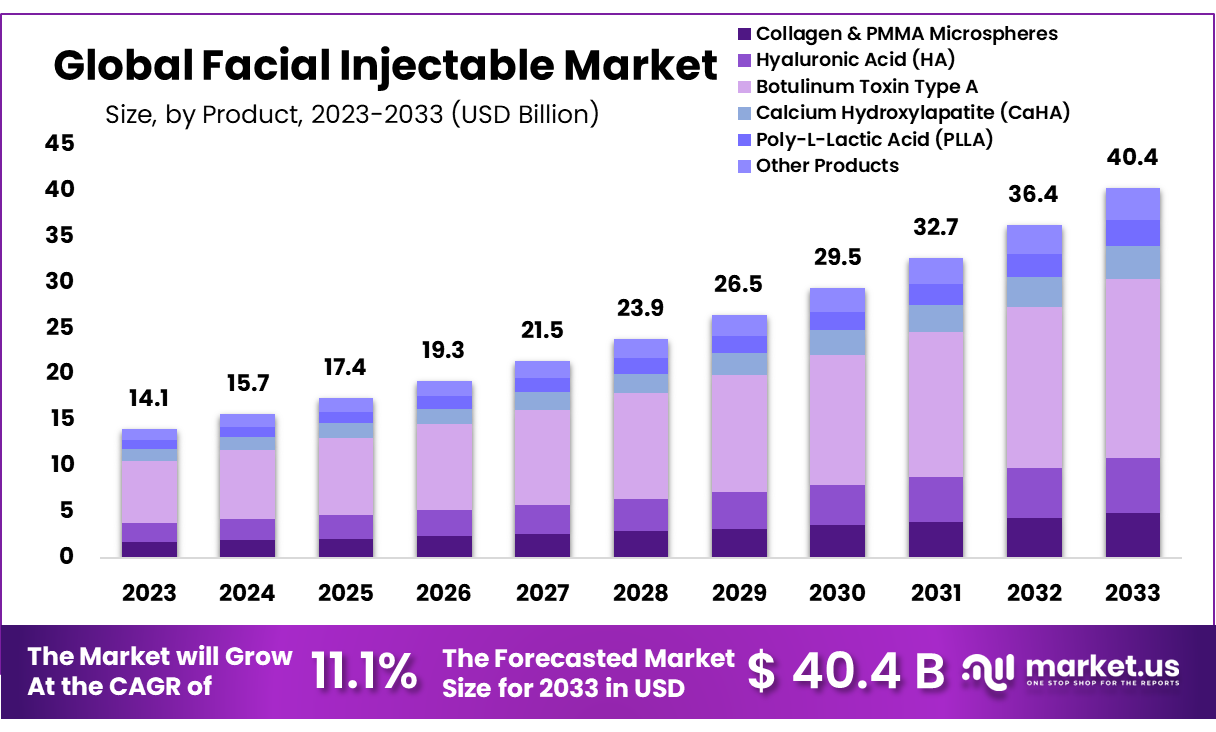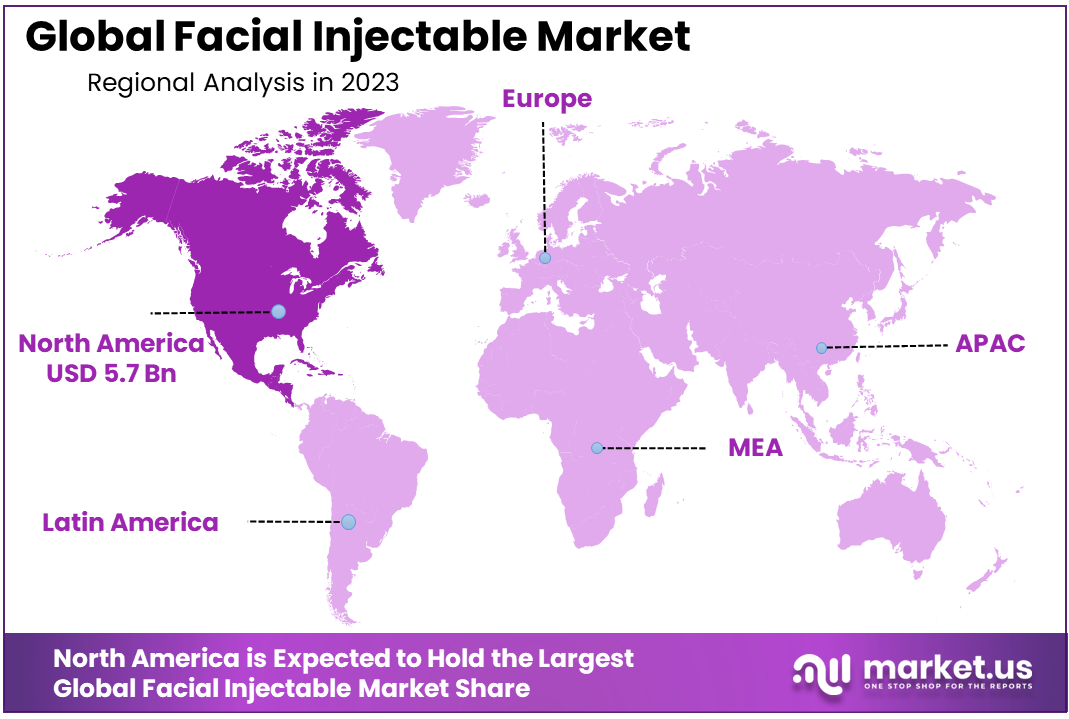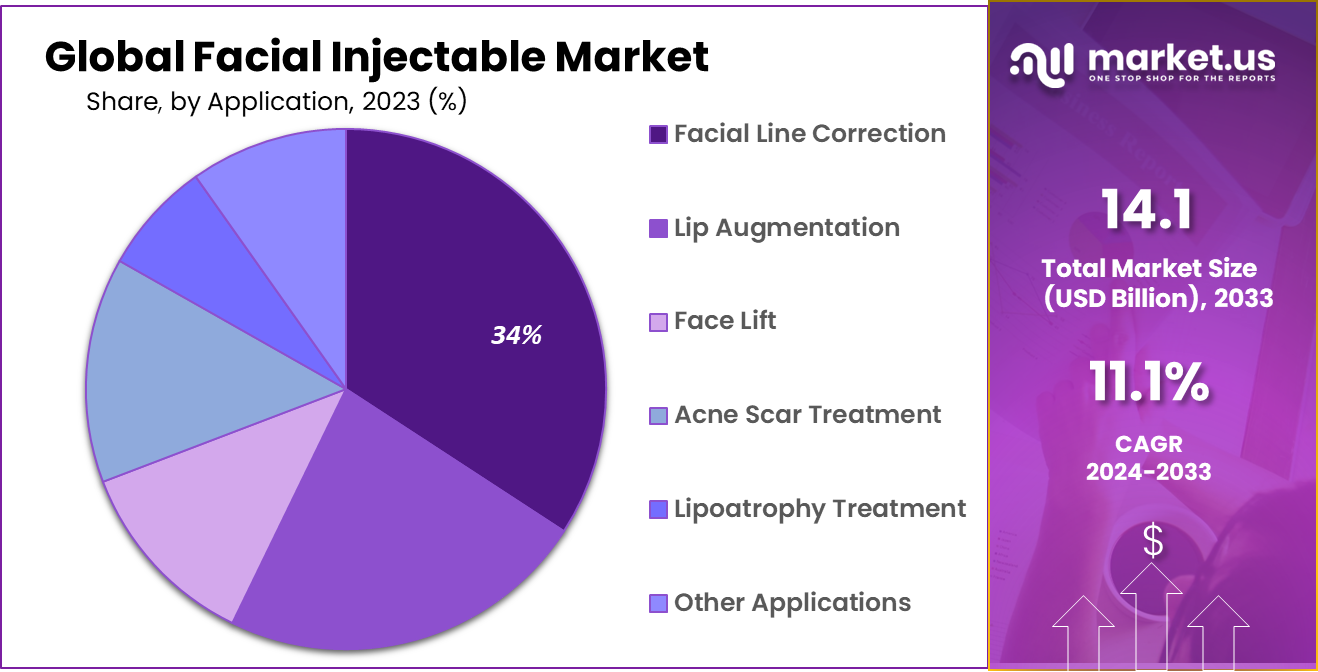New York, Feb. 20, 2024 (GLOBE NEWSWIRE) -- According to Market.us, the Global Facial Injectable Market size is forecasted to exceed USD 40.4 Billion by 2033, with a promising CAGR of 11.1% from 2024 to 2033.
The global facial injectable market encompasses a diverse range of products and procedures aimed at enhancing facial aesthetics and addressing various cosmetic concerns. Facial injectables are specialized fillers targeting different facial regions for various cosmetic purposes, including reducing dark circles, enhancing brow lifts, and addressing issues like lip thinning or cheekbone enlargement. They are also used to minimize wrinkles and restore skin affected by aging, acne, or scars, with common application points including nasolabial folds, cheekbones, lips, eye corners, dorsal areas, and dorsal hands.
The market is experiencing growth driven by increased awareness of minimally invasive procedures, boosted by beauty campaigns from industry leaders. The demand for non-invasive aesthetic procedures and therapies has tripled since 2012, attributed to factors like skin damage from pollution and lifestyle choices, contributing to increased demand for facial injectables. With growing demand for facial injectables driven by interest in facial line correction and rising disposable incomes, the market anticipates significant expansion in the coming years
Explore essential market insights, including key trends, empowering clients to enhance their strategies and maintain a competitive edge. Access a sample PDF report

Key Takeaway
- In 2023, Botulinum Toxin Type A dominated the market, capturing 48.2% of total revenue, driven by its popularity among women in their middle years seeking to reverse aging effects. Hyaluronic Acid (HA) exhibited the fastest Compound Annual Growth Rate (CAGR) of 7.4% over the forecast period, renowned for its moisture-retaining properties and ability to give skin a youthful appearance.
- Facial line correction remained the market's largest segment and accounted for 34.2% of total revenue in 2023, fueled by increasing awareness, interest in physical appearance, and rising disposable incomes in middle-class populations globally.
- When classified based on distribution channels, the market is segmented into MedSpas, cosmetic clinics, and hospitals. Among these, the dermatology clinics segment maintained its stronghold on the market by claiming a market share of 41.5%.
- In 2023, North America dominated the Facial Injectable Market, representing over 40.5% of total revenue, valued at USD 5.7 billion, driven by the high geriatric population in the U.S.A and Canada, which is expected to sustain demand for facial injections. Further, the Asia Pacific region is poised to witness the highest Compound Annual Growth Rate (CAGR) over the forecast period.
Factors affecting the growth of the Facial Injectable Market
- Facial injectables include dermal fillers, botulinum toxin injections, collagen stimulators, and other biocompatible substances administered through minimally invasive procedures. These injectables are utilized to reduce wrinkles, restore volume, enhance facial contours, and rejuvenate the skin, catering to a growing demand for non-surgical cosmetic treatments worldwide.
- Key factors driving market growth include increasing consumer awareness, rising demand for minimally invasive procedures, advancements in product formulations and delivery techniques, and shifting beauty trends favoring natural-looking results.
- Additionally, the expanding aging population, growing disposable incomes, and evolving regulatory landscapes contribute to the market's expansion.
- Conversely, challenges such as safety concerns, regulatory scrutiny, and competitive pricing pressures underscore the need for stringent quality standards, innovation, and effective marketing strategies among industry players.
- Overall, the global facial injectable market represents a dynamic and rapidly evolving segment within the broader aesthetics industry, poised for continued growth and innovation in the coming years.
Top Trends in the Global Facial Injectable Market
- The steadily rising use of dermal fillers represents a prominent trend in the facial injectables market in recent years. Dermal fillers, sought after for their ability to address wrinkles and restore facial volume, have witnessed significant popularity among consumers. This trend underscores a shift towards versatile and efficient solutions in the aesthetics industry, where individuals seek non-surgical options to enhance their appearance.
- The increasing use of dermal fillers not only reflects evolving consumer preferences but also serves as a key driver behind the expansion of the facial injectables market. As demand for dermal fillers continues to grow, fueled by advancements in product formulations and delivery techniques, market players are poised to capitalize on this trend by offering innovative solutions that cater to the diverse needs of consumers seeking facial rejuvenation treatments.
Market Growth
The market for facial injectables is experiencing robust growth driven by several key factors. Rising consumer awareness about non-surgical cosmetic procedures, increasing emphasis on facial aesthetics, and the desire to address signs of aging are fueling demand for facial injectables globally. Moreover, advancements in product formulations and delivery techniques, coupled with growing disposable incomes, particularly in emerging economies, are expanding the market further.
The market's growth trajectory is also supported by the aging population, especially in regions like North America and Europe, where the demand for facial rejuvenation treatments is high. Additionally, strategic initiatives by market leaders, such as investments in R&D, strategic partnerships, and expanding manufacturing capabilities, are contributing to market expansion. As the demand for minimally invasive cosmetic procedures continues to rise, the facial injectables market is poised for continued growth in the foreseeable future.
Macroeconomic Factors
Several macroeconomic factors significantly influence the facial injectables market dynamics. Economic conditions such as GDP growth, employment rates, and disposable income levels directly impact consumers' ability and willingness to invest in cosmetic procedures like facial injectables. In regions with robust economic growth and higher disposable incomes, there tends to be greater demand for aesthetic treatments. Additionally, healthcare spending and insurance coverage policies play a role in determining the accessibility of facial injectables to consumers. Currency exchange rates, inflation rates, and government regulations related to healthcare and cosmetic procedures also affect market dynamics.
Moreover, demographic trends, including population aging and urbanization, influence the demand for facial injectables, with aging populations seeking solutions to maintain a youthful appearance. Overall, macroeconomic factors serve as important drivers and constraints shaping the growth and performance of the facial injectables market.
Regional Analysis
North America emerged as the dominant market for facial injectables in 2023, accounting for over 40.5% of the total revenue, with a market value of USD 5.7 billion. This dominance is attributed to the high geriatric population in the United States and Canada, which is expected to continue driving demand for facial injections in the future. The American Society of Plastic Surgeons (ASPS) reported a remarkable growth in the use of Botox injections, with an 835% increase between 2004 and 2020, indicating the rising popularity of facial injectables in North America. Looking ahead, North America is poised to remain a significant revenue source for facial injectables.
However, the Asia Pacific market is anticipated to witness the highest compound annual growth rate (CAGR) over the forecast period. Countries such as South Korea, Australia, and India are key contributors to the region's growth, driven by a growing focus on physical appearance and increasing demand for facial injections. India, in particular, is expected to experience the fastest growth rate during the forecast period, highlighting the region's potential as a lucrative market for facial injectables in the coming years.
Uncover the actionable insights tailored to your business strategy. Request our brochure to learn more https://market.us/report/facial-injectable-market/#inquiry

Scope of the Report
| Report Attributes | Details |
| Market Value (2023) | USD 14.1 Billion |
| Forecast Revenue 2033 | USD 40.4 Billion |
| CAGR (2024 to 2033) | 11.1% |
| North America Share | 40.5% |
| Base Year | 2023 |
| Historic Period | 2018 to 2022 |
| Forecast Year | 2024 to 2033 |
Market Drivers
The growth of minimally invasive surgical procedures (MIPT) has emerged as a key driver propelling the facial injectable market forward. As consumer preferences shift towards minimally invasive cosmetic treatments offering minimal downtime and reduced risks, the demand for facial injectables has surged. This trend underscores a growing inclination towards non-surgical options for facial rejuvenation, which are increasingly preferred by individuals seeking aesthetic enhancements.
The popularity of MIPT reflects a broader societal trend towards cosmetic procedures that offer natural-looking results with fewer associated risks and complications. As the demand for minimally invasive cosmetic treatments continues to rise, it significantly contributes to the expansion of the facial injectable market, driving innovation and market growth in the coming years.
Market Restraints
The stringent regulatory approval processes represent a significant challenge for companies operating in the facial injectable market. These processes, often time-consuming and costly, can impede the timely introduction of innovative products to the market. Market players aiming to bring new facial injectables to market must navigate complex regulatory frameworks and engage in meticulous strategic planning to ensure compliance with regulatory requirements. The rigorous nature of regulatory approval processes necessitates comprehensive preclinical and clinical testing, extensive documentation, and adherence to strict quality standards.
Moreover, variations in regulatory requirements across different regions and countries further compound the challenges faced by market players seeking global market access. Successfully overcoming regulatory roadblocks requires a commitment to transparency, compliance, and collaboration with regulatory authorities throughout the product development and approval process. Despite these challenges, companies that effectively navigate regulatory hurdles stand to gain competitive advantages by introducing safe, efficacious, and compliant facial injectables to meet the evolving needs of consumers in the aesthetic market.
Market Opportunities
The expanding global aging population presents a significant opportunity for the facial injectable market. As demographics worldwide trend towards aging populations, there is a growing demand for cosmetic solutions to address the visible signs of aging and maintain a youthful appearance. The desire among aging individuals to enhance their aesthetic appeal and counteract the effects of aging fuels the demand for facial injectables, creating lucrative business opportunities for industry participants.
With advancements in technology and increasing consumer awareness about non-surgical cosmetic procedures, the market for facial injectables is poised for substantial growth. Moreover, as the aging population continues to expand, there is a sustained and growing demand for facial rejuvenation treatments, positioning the facial injectable market for continued expansion and innovation in the years ahead.
Access Now for Quick Delivery | Buy Our Premium Research Report https://market.us/purchase-report/?report_id=48313
Report Segmentation of the Facial Injectable Market
Product Insight
Botulinum Toxin Type A, such as Botox, emerges as the dominant product in the facial injectable market, capturing 48.2% of total revenue in 2023. Primarily favored by women in their middle years seeking to counteract signs of aging, Botulinum Toxin Type A injections are renowned for their ability to temporarily relax facial muscles and diminish the appearance of wrinkles and fine lines.
Meanwhile, Hyaluronic Acid (HA) is poised for rapid growth, boasting the fastest compound annual growth rate (CAGR) of 7.4% over the forecast period. HA, known for its exceptional moisture retention properties, plays a vital role in maintaining skin hydration, elasticity, and a youthful complexion. With its ability to penetrate deeply into the epidermis and release antioxidants, cosmetic-grade HA enhances skin plumpness and appearance, prolonging the age-delaying benefits sought after by consumers in the facial injectable market. As consumers increasingly prioritize natural-looking and long-lasting results, the demand for Hyaluronic Acid injectables is expected to surge, driving substantial expansion in this segment of the market.
Application Insight
Facial line correction emerges as the largest segment within the facial injectable market, contributing 34.2% of total revenue in 2023. This segment's prominence is driven by the escalating demand for aesthetic procedures aimed at addressing wrinkles, lip lines, and facial imperfections. With a growing emphasis on physical appearance and increasing disposable income among middle-class populations in developing nations like India, the demand for facial injectables for cosmetic purposes is expected to witness significant growth in the coming years.
As awareness surrounding facial aesthetics continues to rise and individuals seek minimally invasive solutions to enhance their appearance, the demand for facial injectables is anticipated to remain robust, positioning this segment for sustained expansion over the forecast period.
Distribution Channel Insight
In the realm of facial injectables and aesthetic treatments, the dermatology clinics segment has asserted its dominance, securing a substantial market share of 41.5%. This segment's resilience and prominence stem from several factors. Dermatology clinics offer specialized expertise and tailored services, attracting patients seeking cosmetic enhancements and skincare treatments. These clinics often house skilled dermatologists and cosmetic surgeons who possess extensive experience in administering facial injectables and other aesthetic procedures, fostering trust among patients.
Furthermore, dermatology clinics are equipped with advanced technologies and facilities, ensuring the delivery of high-quality treatments in a comfortable and controlled environment. Patients often prefer dermatology clinics for their comprehensive approach to skincare and aesthetics, making them a preferred choice in the landscape of facial injectables distribution channels.
Recent Development of the Facial Injectable Market
- In May 2023, Merz introduced the world's first hyaluronic acid dermal filler from Switzerland called 'Belotero Revive' at the "Reviving your skin, Refreshing your day" event held at Fashion Hall, Siam Paragon. The event showcased the cutting-edge innovation in skincare and aesthetic treatments, emphasizing the importance of skin rejuvenation and vitality.
- In May 2023, Evolus, Inc., a performance beauty company known for its customer-centric approach and breakthrough products, has announced a definitive agreement to become the exclusive U.S. distributor of a line of five unique dermal fillers currently in late-stage development. This strategic move significantly expands Evolus's total addressable U.S. market by 70%, reflecting the company's commitment to offering innovative solutions in the field of aesthetic treatments and dermal fillers.
- In January 2024, Galderma, a prominent player in the dermatology field, has announced the approval from Health Canada for Restylane® SHAYPE™, a hyaluronic acid (HA) injectable intended for temporary augmentation of the chin region. Engineered to provide shaping and building effects on bone with deep injection for a bone-mimicking effect, Restylane® SHAYPE™ is set to be available in Canada starting February 2024.
Tap into Market Opportunities and Stay Ahead of Competitors - Access a sample PDF report

Market Segmentation
Product
- Collagen & PMMA Microspheres
- Hyaluronic Acid (HA)
- Botulinum Toxin Type A
- Calcium Hydroxylapatite (CaHA)
- Poly-L-Lactic Acid (PLLA)
- Other Products
Application
- Facial Line Correction
- Lip Augmentation
- Face Lift
- Acne Scar Treatment
- Lipoatrophy Treatment
- Other Applications
Distribution Channel
- MedSpa
- Dermatology Clinics
- Hospitals
By Geography
North America
- US
- Canada
Europe
- Germany
- France
- The UK
- Spain
- Italy
- Russia
- Netherland
- Rest of Europe
Asia Pacific
- China
- Japan
- South Korea
- India
- New Zealand
- Singapore
- Thailand
- Vietnam
- Rest of APAC
Latin America
- Brazil
- Mexico
- Rest of Latin America
Middle East & Africa
- South Africa
- Saudi Arabia
- UAE
- Rest of MEA
Competitive Landscape
The competitive landscape of the facial injectable market is marked by significant investments by leading market players in their research and development (R&D) departments, aimed at expanding their product portfolios and reaching a broader market. These companies prioritize strategic initiatives such as introducing new products, securing contracts, and pursuing mergers and acquisitions to enhance their market presence and increase investments.
Moreover, market leaders in the facial injectable segment are committed to offering their products at affordable costs to ensure accessibility for a wider consumer base. Looking ahead, these companies are exploring opportunities to establish regional manufacturing facilities to streamline operations and reduce costs, with facial injectables emerging as a key focus area in this regard. By leveraging strategic investments and operational efficiencies, market leaders are poised to maintain their competitive edge and drive sustained growth in the facial injectable market.
Market Key Players
- Ipsen
- Merz Pharma
- Suneva Medical, Inc.
- Medytox Inc.
- Sinclair Pharma
- Bloomage BioTechnology Corporation Limited
- Anika Therapeutics Inc.
- Prollenium Medical Technologies
- Galderma
- Allergan, Inc.
- Other Key Players
Explore More Life Science Market Research Reports
- Physiotherapy Equipmen Market Upcoming Trends and Top Company Analysis Report by 2032
- Defibrillator Market: Saving Lives with Cutting-Edge Cardiac Technology
- Human Insulin Market Latest Research Reveals Key Trends for Business Growth 2023-2032
- Oligonucleotide Synthesis Market: Advancements in Genetic Research
- Opioids Market 2023 Opportunities, Value Chain and Sales Channels Analysis 2032
- Plastic Injection Molding for the medical device market is projected to be US$ 72,556.7 Mn in 2018 to reach US$ 136,167.0 Mn by 2028 at a CAGR of 6.5%.
- Surgical Hat Market size is expected to be worth around USD 777.38 Billion by 2031 from US$ 551.1 billion in 2021
- Active Humidifier Market size is expected to be worth around USD 1682.9 Million by 2033 from USD 1569.5 Million in 2023
- Medical Devices Vigilance Market size is expected to be worth around USD 174.2 Billion by 2033 from USD 79.2 Billion in 2023
- Single Use Cystoscope Market size is expected to be worth around USD 191.6 Million by 2033 from USD 83.2 Million in 2023
About Us:
Market.US (Powered by Prudour Pvt Ltd) specializes in in-depth market research and analysis and has been proving its mettle as a consulting and customized market research company, apart from being a much sought-after syndicated market research report-providing firm. Market.US provides customization to suit any specific or unique requirement and tailor-makes reports as per request. We go beyond boundaries to take analytics, analysis, study, and outlook to newer heights and broader horizons.
Follow Us on LinkedIn
Our Blog:
